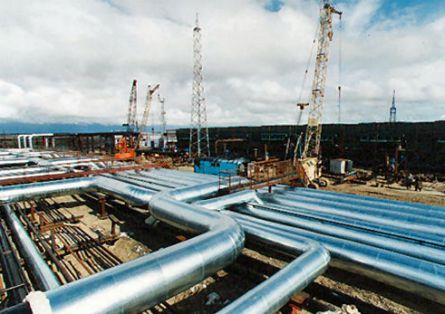
Russia Hiding Gas Shortfall by Touting Multiple Export Routes
Publication: Eurasia Daily Monitor Volume: 6 Issue: 7
By:

Russia is using the gas supply crisis, which it has itself triggered, to induce a contest among consumer countries over imports of Russian natural gas. Russian-produced gas has become a commodity in short supply when measured against Russia’s internal requirements and its existing export commitments.
The shortfall had been prognosticated to set in by 2010-2011 but can already be observed. Anatoly Chubais’s public forecast in 2008 (while still head of Russia’s electricity monopoly) that the gas shortfall might occur as early as in 2009, seems on the mark. The structural cause of this shortfall is chronic underinvestment in new Russian gas fields. Compounding this factor, the recent credit crisis and falling oil and gas prices are derailing Gazprom’s investment plans in new fields and pipelines. This process will prolong the period of production shortfalls and stagnant exports of Russian gas. It will also widen still further the gap between rising European and world demand on one hand and Russia’s stagnant export potential on the other hand.
Recalling a Soviet-era term, Russian natural gas is becoming a “defitsitnyi tovar” (commodity in short supply), the cause of this process ultimately traceable to faulty state planning in Moscow. Russia as well as the Western consumers who had counted on Russian gas must brace themselves for that situation. Moscow is seeking to turn the situation to its own advantage by playing off various consumer countries against each other.
Russian Prime Minister Vladimir Putin made particularly crude attempts in this regard in his January 10 and 12 press conferences. He warned and, alternately, tantalized the international audience. He threatened to prolong the halt of deliveries via Ukraine to Europe while in the next breath boasting that Russia could use multiple routes of delivery to the consumer countries of Russia’s choice. Those routes, however, are for the most part yet to be financed and built and hardly likely to materialize, barring some monumental policy miscalculations in Berlin or Brussels.
In that vein, Putin ticked off Russia’s delivery options: Nord Stream (the planned Russo-German pipeline on the Baltic seabed); Yamal Two (a proposed pipeline via Belarus and Poland westward), “if there is demand after building Nord Stream”; South Stream (Gazprom’s proposed export system via the seabed of the Black Sea and the Balkans to Central Europe); expansion of Blue Stream (also via the Black Sea, from Russia to Turkey); and a proposed gas pipeline to China (parallel with the planned oil pipeline to China) and possibly to other gas consumer countries in the Asian Far East.
These are just the delivery options by pipelines-to-be-built, if Putin is to be believed. But he added liquefied-natural-gas (LNG) options: Russia, he said, could build gas liquefaction plants as well as an LNG tanker fleet for exports of Russian gas to worldwide destinations such as North America. “Thank God, we have that gas,” Putin bluffed (Interfax, Itar-Tass, Vesti TV, January 8, 10).
But Russia has neither all that gas and nor the financing to develop it, the industrial capacity to make the steel pipes, or the LNG technology. Moscow, however, hopes to strike bilateral deals with Western companies and governments, which would compete against each other for access to Russian gas in short supply.
Hardly anyone at Putin’s news conferences and few in the subsequent media commentaries called that bluff. Perhaps it was too transparent. Russia is far short of the potential to fill those pipelines to anything near their putative annual capacities (55 billion cubic meters [bcm] for Nord Stream, hypothetically some 15 bcm for Yamal Two, a seemingly arbitrary figure of 50 bcm for South Stream, an extra 8 bcm for Blue Stream, plus an undeclared but presumably massive figures for China and other Asian countries). All this would supposedly come on top of the volumes that Russia traditionally exports via Ukraine (some 120 bcm annually); and on top of all that comes the declared intent to export LNG by a fleet of tankers.
Moscow claims that those putative options are not intended to bypass or eliminate the Ukrainian route, but rather to supplement it. The Nord Stream consortium takes the same line publicly, as its German chief, ex-Chancellor Gerhard Schroeder, reiterated in Putin’s presence in St. Petersburg (www.premier.gov.ru, January 7; Interfax, January 10; Moscow Times, January 12). If so, those multiple Russian export options become even less credible in the aggregate.
Gazprom and the Kremlin currently seem to be giving Nord Stream the first priority in terms of planning, seeking international financing, and the hypothetical allocation of future gas volumes. There is no comparable Russian activity behind South Stream or other pipeline projects at this time. Gazprom’s production and revenue shortfalls have forced Moscow to select one priority at this stage and that appears to be Nord Stream.
Behind the public relations hype, Moscow is trying to pressure its Nord Stream consortium partners into lobbying the European Union to finance this project. In his press conferences, Putin warned that Russia could change its plans with the future gas output from the Shtokman field, earmarking that output for future export to the United States, instead of Germany and other West European countries. Putin declared: “Yes, really, the American partners have long been asking us to do it. We will do it. We have reallocated the bulk of the [projected] output from Shtokman to the European market, but if things go as they are going now, we may reassign it again to America” (Interfax, January 12).
Shtokman is Russia’s richest gas field and its development lags years behind schedule. By 2005-2006, the Kremlin was discussing with U.S. and Canadian companies the possibility of launching liquefaction projects in Russia to supply North America with Russian gas. From 2006 onward, Moscow signaled a preference for German and other European consumer countries to receive Shtokman gas in the future. Now, Putin is signaling another possible switch of preferences, back to North America. He speaks of “reassigning” and “reallocating” as an ongoing process, trying to play potential consumers off against each other and finance Russia’s strategic projects. Russia is seeking to convert its gas shortfall into strategic leverage as long as Europe does not manage to open direct access to non-Russian gas in Central Asia and the Middle East.




